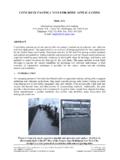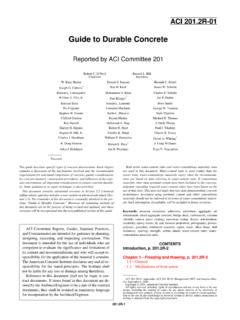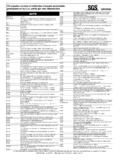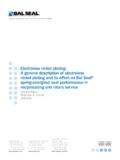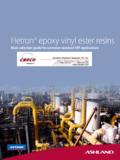Transcription of Abrasion Test Methods for Paving Units Compared
1 Proceedings of the 7th International Conference on Concrete Block Paving (PAVE AFRICA 2003)12th 15th October 2003 ISBN Number: 0-958-46091-4 Sun City, South AfricaProceedings produced by: Document Transformation Technologies Conference Organised by: Conference PlannersABRASION TEST Methods FOR Paving Units COMPAREDP ettit, TopPave standards for Paving products have been prepared by Comit Europ en de NormalisationTechnical Committee 178 (CEN/TC178). In the specific case of block Paving , separate standardshave been prepared for clay and concrete block Paving Technical Committees were requested to ensure that a specific property should be measuredby the same test method regardless of the product material. Although this ideal situation could notbe realized in the first generation of European Paving standards, it is a requirement of CEN forsecond generation standards. Against this background, Interpave, the UK trade association forprecast concrete Paving and the Brick Development Association (BDA) the UK clay pavingassociation entered into a joint research project to evaluate a number of Abrasion test Methods withthe objective of establishing a universal method which would be equally suitable for both clay andconcrete Paving concrete block paver types, 3 concrete flag types and 4 clay paver types were used for theprogramme.
2 The Abrasion tests evaluated were the wide and narrow wheel Methods , the B hmemethod called up by European Paving standards and additionally the Sydney Council INTRODUCTIONThe new European block Paving standards issued by the Comit Europ en de Normalisation(CEN)the European committee for standardization which will replace all conflicting national standards inCEN member countries, in common with other product standards, have taken many years to time taken is a reflection of both the difficulty in reaching consensus and the drafting guidanceand requirements given to CEN Technical prepared by the same Technical Committee (CEN/TC178) and containing similarrequirements, EN 1344 for clay block pavers and EN 1338 for concrete block pavers measureproperties using different test Methods . During the drafting process there were calls both from CENand nationally that the same property should be measured by the same test method for both clay andconcrete block pavers.
3 However this objective generally could not be achieved in these firstgeneration of European standards . In the specific case of Abrasion resistance not only was it notpossible to agree on a single test for clay and concrete pavers it was not possible to agree on a singletest for concrete pavers. In consequence the concrete block paver standard contains 2 tests forabrasion resistance one of them a reference test and the other a so called alternative clay paver Abrasion resistance tests and the concrete paver Abrasion resistance reference test arevariations on a single concept and the calls for harmonizing these into a single method areunderstandable in the light of the many similarities between the 2 CEN have agreed, as an expedient, to permit 2 Abrasion resistance tests for concrete blockpavers in the first generation of European standards it is clear that the rules of having only one testfor a property will be strictly enforced in the second generation standards which are due in 5 yearstime.
4 With the anticipated stricter application of the rules within CEN and the need to try andharmonize test Methods across product types, Interpave, the UK trade association for concretepaving in conjunction with the Brick Development Association (BDA), the UK trade association forclay bricks and pavers agreed to collaborate in joint research with the objective of establishing asingle method which had the potential of being adopted as the universal test method for abrasionresistance. The test, to meet this objective, would need to give results which were reasonablerepresentations of product performance and which subjectively and objectively did not favour eitherclay or in publishing the European standards led UK industry to drive forward changes to BritishStandards for both clay and concrete pavers and these revised standards were closely modelled onthe then draft European standards.
5 These were both published in 2001. Changes to these Britishstandards meant that European Standard compliant products were available to be selected for thetest concrete block paver types, 3 concrete flag types and 4 clay paver types selected as beingrepresentative of typical products were selected for the programme. All specimens were tested bythe wide and narrow wheel method and the B hme method called up by European standards andadditionally by the Sydney Council TEST Methods evaluatedEN 1344: 2002 Clay pavers Requirements and test Methods : Method for the determination of Abrasion resistance . (Narrow wheel method)EN 1338: 2003 Concrete Paving blocks Requirements and test Methods : Measurement of Abrasion resistance . (Wide wheel method)EN 1338: 2003 Concrete Paving blocks Requirements and test Methods : Measurement of Abrasion according to the B hme test. (B hme method)AS/NZS : Masonry Units and segmental powers Methods of test; Method 9: Determining Abrasion resistance .
6 (Sydney Council method) Principles of measurement Narrow wheel methodA steel disc of 200mm diameter and 10mm width is rotated at 75rpm for 2 minutes whilst itsperimeter is held in contact with a test specimen. Carborundum (white fused aluminium oxide ofgrain size F80) is fed between the contact surfaces for the duration of the contact force between specimen and disc is determined as that required to produce a chordlength of 24mm using a reference material (transparent fused silica) after 150 result of the test is expressed as the mean volume of material removed from 2 measurements oneach of 5 Wide wheel methodA steel disc of 200mm diameter and 70mm width is rotated at 75rpm for 1 minute whilst itsperimeter is held in contact with a test specimen. Carborundum (white fused aluminium oxide ofgrain size F80) is fed between the contact surfaces for the duration of the contact force between specimen and disc is determined as that necessary to produce a chordlength of 20mm using a reference material (Boulonnais marble) after 75 result of the test is expressed as the chord length of the groove produced in the specimenadjusted by a calibration tests on a specimen are advised when the largest of the 2 chords produced is taken as B hme methodA dried specimen is held in contact with a standard abrasive spread around the test track of a750mm diameter cast iron disc.
7 The contact force between the specimen and the disc is 294 + disc is rotated at 30rpm when loaded and each of the required 16 cycles, during which thespecimen is progressively rotated through 90o, consists of 22 Sydney Council methodA square section tumbler box containing steel balls and with test specimens clamped into openingsin the opposite faces is rotated at 60rpm for 60 minutes. The long inside edges of the tumbler havefillets to assist the flow of the steel balls during the Abrasion index is calculated by dividing the mass loss of each specimen by its bulk PRODUCTS Concrete paversRefDescriptionCBP 1 Gravel aggregateCBP 3 Granite aggregateCBP 4 Limestone Concrete flagsRefDescriptionF1 Sandstone aggregateF2 Granite aggregateF3 Gravel Clay paversRefDescriptionCL 1 Dense redCL 2 Blue Engineering typeCL 3 Medium buffCL 4 Soft terracotta4. TEST Narrow wheel methodThere are many similarities between this method and the wide wheel method (egs wheel diameter,speed of rotation, abrasive medium).
8 One of the significant differences between the 2 Methods is therequired duration of the test. The narrow wheel requires this to be 2 minutes rather than the oneminute required for the wide wheel method. To provide a more comprehensive evaluation of themethod for the programme and comparison with the wide wheel method additional measurements at1 minute were carried out for each specimen 1. Narrow wheel method results, Contact time 1 length (mm)SampleReferenceGroove AGroove BMean(rounded)valueMaterialremovedV(m3)C B1 2. Narrow wheel method results Contact time of 2 minutesas specified in EN length (mm)SampleReferenceGroove AGroove BMean(rounded)valueMaterialremovedV (m3) Wide wheel methodThe specified duration for the test in EN 1338 is 1 minute but to enable better comparison with thenarrow wheel method the test was also carried out for 2 minutes on each specimen type.
9 This is thetest time required by EN 1344 (Narrow wheel method).Table 3. Wide wheel method ONE 1 MINUTETEST TWO 2 MINUTESS ample referenceCorrected chord length (mm)Corrected chord length (mm) B hme methodThis test was carried out as specified in EN 1338. It was noted that no means for keeping theabrasive evenly distributed as directed was specified and the laboratory felt that this could meanthat the method was operator 4. B hme method wear (1000mm3/5000mm2)SAMPLEREFERENCES ample 1 Sample 2 Sample Sydney Council methodThe number of specimens available meant that there were insufficient to fill all 4 sides of thetumbler with similar products. Consequently 2 opposite sides of the tumbler were blanked off withsteel plates so only the remaining 2 sides were loaded with specimens. The laboratory also haddifficulty sourcing 600 diameter steel balls and 1000 diameter steel balls were earlier work it had been found that this number and size of steel ball resulted in the was noted by the laboratory that the specimens at the end of the tumbler were only abraded overpart of their area.
10 Therefore it was decided to divide the Abrasion index by the exposed area of eachspecimen to take account of the partial Abrasion of some of the 5. Sydney Council method IndexArea (cm2) Abrasion IndexArea (cm2) Abrasion IndexArea (cm2) Abrasion IndexArea (cm2) Abrasion IndexArea (cm2) Abrasion 5. IndexArea (cm2) Abrasion IndexArea (cm2) Abrasion IndexArea (cm2) Abrasion IndexArea (cm2) Abrasion IndexArea (cm2) Abrasion Values plottedTo enable graphical comparison of the values measured by the test Methods under consideration,the following multiplication factors were applied to the measured values:Narrow wheel method x 10-1B hme method x 10-3 The resulting values in table 6 were 6. Values wheel - 1min wheel - 2min wheel - wheel - hme5 8 231413109 8 1323 Sydney referenceMeasured valuesNarrow wheel - 1min Narrow wheel - 2minWide wheel - 1minWide wheel - 2minB hmeSydney CouncilFigure 1. Comparison of referenceMeasured valuesNarrow wheel - 1min Narrow wheel - 2minWide wheel - 1minWide wheel - 2minB hmeSydney CouncilFigure 2.
